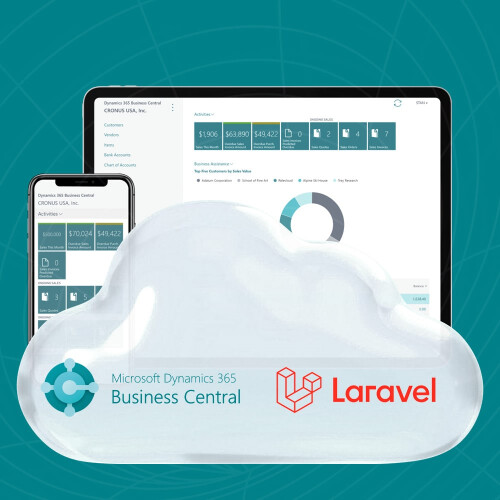The world of web development is vast, dynamic, and extremely diverse. The integration of platforms like Microsoft Dynamics 365 Business Central (BC) and Laravel demonstrates how complex and powerful modern systems can be. In this article, we will dive deep into this exciting topic and discover why this particular integration is so innovative and promising for the future.
What are Microsoft Dynamics 365 Business Central and Laravel?
Microsoft Dynamics 365 Business Central
Microsoft Dynamics 365 Business Central (often simply referred to as "Business Central" or "BC") is a part of the Microsoft Dynamics family and is considered an all-in-one business solution. It is an ERP (Enterprise Resource Planning) system designed specifically for small to medium-sized businesses.
Business advantages of Business Central:
-
Holistic business management: With BC, companies can manage finances, sales, service, and many other business areas in a single solution, reducing silos and increasing efficiency.
-
Scalability: As a cloud-based solution, BC can scale with the growth of a business, making investments in expensive hardware or manual upgrades unnecessary.
-
Integration: As a Microsoft product, Business Central offers seamless integrations with other Microsoft products such as Office 365, enhancing productivity and collaboration.
-
Data security: Benefit from Microsoft's advanced security protocols and infrastructure to ensure your business data is always protected.
Laravel
As a leading PHP framework, Laravel provides the perfect combination of ease of use, scalability, and security for realizing complex digital solutions. It is the bridge between idea and implementation, enabling efficient creation and management of customized web applications.
-
Web applications: Whether simple landing pages, extensive news portals, or community platforms – Laravel is the backbone of many modern and responsive web applications used by millions daily.
-
Customer dashboards: Interactive, user-friendly, and data-driven dashboards are not witchcraft with Laravel. Companies use it to provide customers with detailed insights into their accounts, histories, or other specific real-time data.
-
SaaS products: Laravel is excellently suited for developing Software-as-a-Service products. With its modular architecture, scalable and reliable SaaS solutions can be developed.
More details about Laravel can be found here.
While Microsoft Dynamics 365 Business Central focuses on providing businesses with a comprehensive business solution that unites all aspects of their operation under one roof, Laravel provides the tools to develop powerful and customized web applications, customer dashboards, or e-commerce solutions. Combining these two systems can help businesses optimize their digital processes and gain a competitive advantage in today's digital landscape.
Why should these two systems be connected?
In the modern business world, efficient processes are the key to competitive advantages. The connection of Microsoft Dynamics 365 Business Central and Laravel is not just a technical integration of two systems – it's the merging of business intelligence with powerful web technology.
Through this integration, businesses can:
-
Centralization of data: Instead of working in separate silos, integration allows the free flow of information between systems. This ensures that all departments have access to up-to-date and consistent data, leading to better-informed decisions.
-
Automation of workflows: Manual data transfers or duplicate data entries are a thing of the past. Through the connection, for example, orders from a Laravel web application can be directly processed in Dynamics 365 Business Central, reducing human error and accelerating processes.
-
Real-time insights: With seamless integration, businesses can access reports and analytics in real time. This means decision-makers do not have to wait for data to be transferred from one system to another – they have immediate access to the information they need.
-
Enhanced customer experience: When customer data is synchronized between a Laravel-based customer portal and Dynamics 365 Business Central, companies can create personalized customer experiences and respond more quickly to customer inquiries.
Overall, connecting these two systems leads to drastic process optimization. Businesses can operate more leanly, responsively, and efficiently, ultimately leading to improved operational results and more satisfied customers.
How is the integration carried out?
Step 1: Data Access
Business Central provides a variety of APIs. This enables Laravel to seamlessly retrieve and send data. A corresponding API module within Laravel can be developed for this purpose.
Step 2: Authentication
Security is of the utmost importance. Therefore, OAuth2 authentication should be used to ensure that only authorized applications can access BC data.
Step 3: Data Transfer and Processing
Once authentication is set up, data can be transferred between BC and Laravel. Laravel can process this data and store it in its own databases as needed.
Step 4: User Interface and User Experience
The user interface (UI) and user experience (UX) play a crucial role when it comes to how end-users interact with an integrated solution. When Microsoft Dynamics 365 Business Central and Laravel work together, creating a seamless, intuitive, and responsive user interface is essential.
Customization to the User:
One of Laravel's greatest strengths is its flexibility in frontend development. This allows developers to create a tailored UI that's specifically adapted to the needs of the end-users. Whether you need a simple dashboard view or complex data visualization, Laravel provides the tools and libraries to turn your vision into reality.
Maintaining Consistency:
While personalization is important, the user interface must also be consistent. When data from Business Central flows into a Laravel application, the presentation of this data should be consistent in both design and functionality. This ensures that users are not confused or frustrated when they switch between systems.
Responsiveness:
In our increasingly mobile world, it's essential that the user interface performs well on different devices and screen sizes. Laravel enables the development of responsive designs that automatically adjust to tablets, smartphones, and desktops.
Feedback and Iteration:
It's important to regularly gather feedback from end-users and adjust the user interface accordingly. This ensures that the solution not only works but is also liked by the users and makes their daily work easier.
Integration of Features:
Another advantage of combining Business Central and Laravel is the ability to integrate advanced features into the user interface. This could be a chatbot, advanced search functions, or special reporting features that go beyond what Business Central alone can provide.
The user interface is the window through which your users see and experience the power of the integration of Business Central and Laravel. A thoughtful, well-designed, and functional user interface can make the difference between a good and a great user experience.
Bidirectional vs. Unidirectional Connection: Which is Right for You?
When you decide to integrate Microsoft Dynamics 365 Business Central and Laravel, an important question arises: Should the connection be bidirectional or unidirectional? Both have their own advantages and disadvantages, depending on your company's specific requirements. Let's take a closer look.
Bidirectional Connection
With a bidirectional connection, data flows in both directions: from Business Central to Laravel and vice versa. This means that changes made in one system are automatically updated in the other.
Advantages:
- Real-time data synchronization: Both systems are constantly up to date.
- Improvement in data integrity: Reduces the risk of data inconsistencies between systems.
- Automation: Automates recurring tasks and processes that otherwise would need to be done manually between the systems.
Challenges:
- Complexity: A bidirectional integration can be more technically demanding.
- Error handling: Errors in one system can affect the other. Robust error handling is essential.
Unidirectional Connection
A unidirectional connection means that data flows in only one direction, either from Business Central to Laravel or vice versa.
Advantages:
- Simplicity: The integration is often less complex as it works in one direction.
- Control: Since data flows only in one direction, the risk of data errors or inconsistencies can be reduced.
Challenges:
- Timeliness: One system may not always have the most current data, depending on how the integration is set up.
- Manual interventions: Manual updates or reconciliations between the systems may be necessary.
The decision between bidirectional and unidirectional connection depends on your business requirements.
Challenges and Solutions
As with any integration, there are challenges. These include data inconsistencies, latency issues, and potential security concerns. An experienced partner can help overcome these challenges and ensure a smooth integration.
Conclusion
Digital transformation forces companies to constantly look for ways to become more efficient and competitive. Connecting Microsoft Dynamics 365 Business Central and Laravel is a shining example of how two powerful systems can work together to optimize business processes and maximize benefits for companies.
By combining the comprehensive business functions of Dynamics 365 with the flexibility and scalability of Laravel, doors open to new possibilities in web development, data analysis, and customer experience. This synergistic approach allows companies to quickly adapt to changing market conditions, make data-driven decisions, and ultimately offer their customers superior services.
For IT decision-makers looking for a way to further refine their business processes while also strengthening their digital presence, the integration of Microsoft Dynamics 365 Business Central and Laravel offers a clear path to the future. It's not just a matter of technology, but also a vision to bring both systems together in a way that creates real business value.
If you are interested in such an integration or have questions about it, feel free to contact us or submit a project inquiry.



